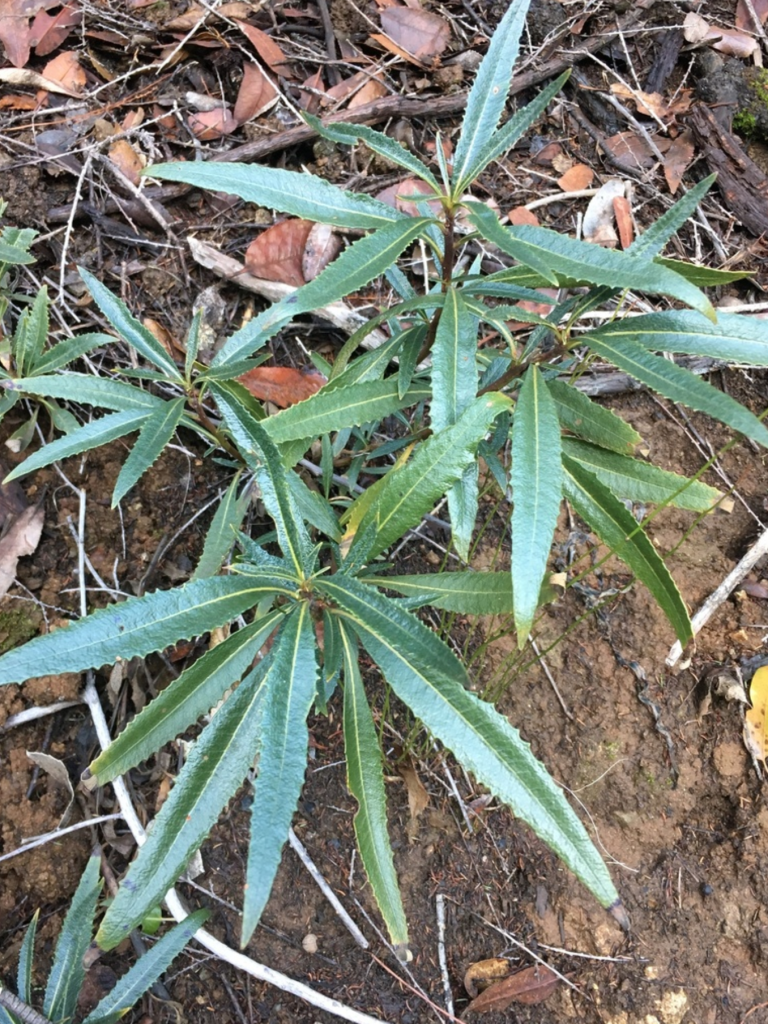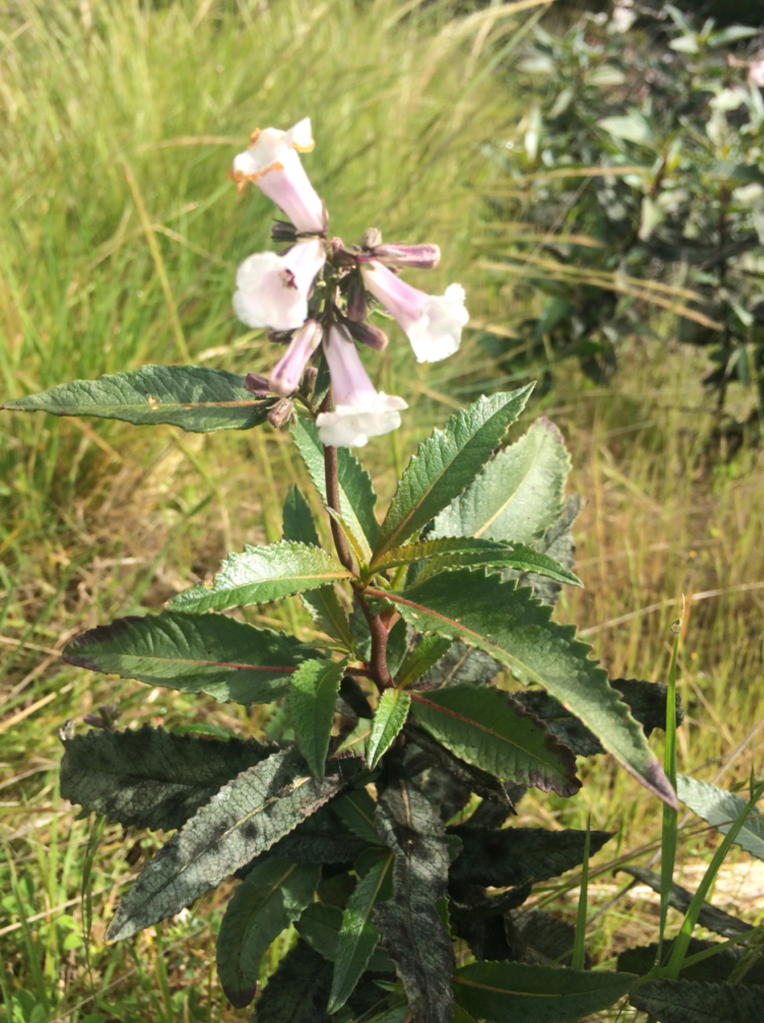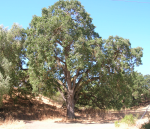
California white oak, at Sycamore Grove
Part 1 of this article summarized explanations by many members of the Yahoo Gardening With Natives online group about why many people don’t consider native plants in their landscaping.
Part 2 offers some strategies suggested by GWN members that may be useful in bringing the value and beauty of native plants to the attention of the public.
Re-Discover California’s Sense of Place
“The true native plants of California have been been beaten back by a massive onslaught of weeds. Much of what people perceive on the California landscape is really a degraded, non-native landscape. We need to regain a sense of the place we live in.”
“A culture of native plants is lacking in society, and with it, a scarcity of professionals who know how to design a native landscape. People also need to be able to look beyond what they are familiar with, and replace it with a different vision.”
“It occurred to me one day as I was working in my garden that native plants were successful in California because, over time, they had adapted to the climate here – the summer heat, the availability of water, the different soil types, and our many different microclimates. Things didn’t grow here if they were not suited to the environment. But our predecessors went about trying to adapt the environment to their needs and expectations. Thus, we expect there to be a limitless supply of water for our gardens, we invest in soil amendments and fertilizers and pesticides, and we complain about the expenses required to manipulate the environment to suit our desires. We need to respect where we live.”
“If I hadn’t had the experiences in childhood of wandering in open fields, of watching birds and butterflies, and smelling different kinds of plants, I probably would not have paid any attention to native plants and how they can enrich our lives. To me the question is, how and where can children have the experiences needed to develop a love of nature, when so much of our surroundings consists of artificial landscaping and high density housing?”
“When children are brought up disconnected from the natural world, they grow up not seeing any specific usefulness or physical or emotional connection to nature. What will our suburban kids remember of nature when they grow up?”
Discover What People Need to Know, and What Professionals Need to Teach
“How can the average Californian learn what our native plants are? Trying to discover this on one’s own is not a priority for many typical homeowners.”
“Natural landscapes are not necessarily thought of as gardens, but more as curiosities. Thinking of a native landscape as a garden is something that has to be taught and demonstrated.”
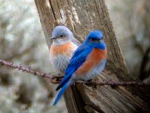
Western bluebirds – mommy and daddy
“One of the ways I’ve seen people develop an interest in natives is by their wanting to attract birds or pollinators to their gardens.”
“Many people want to attract bees and butterflies to their yards. Yet, many of the insects and other animals that are native to California have trouble finding the plants that they have evolved with. In fact, it has been said that nonnative plants could even harm birds that eat them.”
“One way to get more natives planted is to get our cities, counties and states to plant natives. If these entities are growing and propagating natives so that people see them every day, more people will plant them too.”
“I tend to think of things like docenting at Edgewood Park in Redwood City, where people of all ages are leaders on native wildflower walks. Most people have never taken a hike in an unsullied native habitat and have never seen a native landscape. I would emphasize
seeing natives in botanic gardens. We have some outstanding ones here in the area – Tilden Park in Berkeley, Menzies Garden in the SF Botanical Garden, Woodside Public Library native garden. And many others! Hopefully this will become a trend that will only grow and grow, to counteract the reality that nature is becoming more and more remote from peoples’ lives.”
“Go to Golden Gate park and look at all the native plants they’ve planted, and how amazing that park looks. If people realized that their yard could look like that, they’d be more open to it.”
“Many professional gardeners have a limited knowledge of native plants and their care and characteristics, and they are not necessarily motivated to learn about them. But projects can’t just be handed off to someone without oversight. Someone who cares about natives needs to be involved. I suppose that a greater demand for the services of native plant gardeners will eventually lead to more qualified gardeners.”
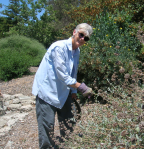
Mary Ann – one of the original GNG volunteers, and currently another faithful caretaker who is an expert at identifying plants!
“You can recommend going on the garden tours of native plant gar- dens. I think people have to see the plants before they get interest- ed. I fault the nursery trade for not using natives. The big problem is that they do not always look good in containers, and they don’t keep well in containers since most have deep root structures. The nurseries need to assist people in learning how to choose the most appropri- ate natives for their situation, and how to care for them.”
“I try to remain positive when talking to people about their landscapes. it’s easy to criticize people’s gardens/yards, and it’s also easy to feel superior when you have some exclusive knowledge, but we need to remember that most yards are the result of a combination of good intentions and neglect, as well as everything in between.”
“We are all ambassadors of the native plant movement, so we really need to be respectful of people’s choices. Plus I think it can really help us to understand why people plant what they do or what they did. If their experience in talking to you about their yard is a positive one, then they are very likely to remain open to suggestions. But if they feel judged in any way for past decisions, they are likely to have a negative experience – which gets us NOWHERE. Besides, why criticize people at all? We have our governments to criticize at every opportunity.”
“Now that I see the reasons for gardening with natives, I feel the message is great but it needs to be told in positive ways – stressing the benefits, not by a threatening or sarcastic condemnation of traditional landscaping. I think the native gardening message just needs the right advocacy. People like what they know and are familiar with. So we need to encourage the good, not trash the preferences of people who don’t understand yet.”
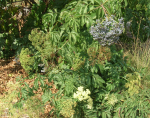
Elderberry – a native plant with multiple uses for Native Americans
Discover the History of Native Plants
“The indigenous people of Califor- nia ate many of our native plants. Almost every native plant had some usefulness for them for nourish- ment, for fashioning tools, for household goods, medicines, clothing, weapons, even toys and musical instruments. Yet, not one of those plants has caught on as food for us newcomers, and nothing about those plants is valued by us. An awareness of these uses puts us to shame and increases the awesomeness of native plants. ”
“The Native Americans in California regarded themselves as an integral part of nature. Instead of trying to dominate nature, they learned to use natural resources to support their communal needs – for food, medicines, tools, utensils, housing, even entertainment – without exhausting or destroying these resources. They developed the wisdom and knowledge of sustainability, to ensure that the plants and animals they depended on actually thrived from being used wisely and judiciously. But us? We use up what we need and move on to somewhere else, and use it up there.”
“Once upon a time, I wanted to plant a tree for birds, and almost after a year of research somebody mentioned native plants. I had asked people for years what were the beautiful blue bushes along Hwy. 280 (they were Ceanothus). Nobody knew. It had never crossed my mind that garden plants were not native. Why would somebody plant something that was totally out of its range, required so much water and was totally useless for wildlife?

Buckwheat – a real honeybee magnet!
Help People Appreciate Nature
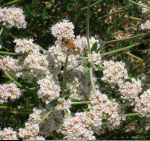 “The reason I love my native yard is that it has tons of wildlife. There is always something happening there. I cannot wait to get home and watch. My lizards are patrolling the kingdoms I build for them. Hummingbirds are beating each other up. Scrub jay trying to kidnap my lizard. California towhee jumping up and down and kicking my mulch all over and making a mess. A clucking squirrel, the one who replanted my buckeye seeds at a different part of the yard (not where my landscape designer designed to plant a buckeye). A flock of bushtits raiding my Lavateras. Chickadees hanging upside down. Fat bees trying to get into penstemons that are too big for them. Why are they doing that upside down? Mourning doves looking like they are grooming each other. Robins waiting for me to leave so they can take over the yard. Not to mention gigantic spiderwebs, beautiful red dragon ladies, hundreds of ladybugs (looking like rubies) on milkweed, and butterflies. And my jewel – a hawk dating in my yard! Even the plants seem to have their own lives and surprise me. Would I get that in a yard with only a lawn?”
“The reason I love my native yard is that it has tons of wildlife. There is always something happening there. I cannot wait to get home and watch. My lizards are patrolling the kingdoms I build for them. Hummingbirds are beating each other up. Scrub jay trying to kidnap my lizard. California towhee jumping up and down and kicking my mulch all over and making a mess. A clucking squirrel, the one who replanted my buckeye seeds at a different part of the yard (not where my landscape designer designed to plant a buckeye). A flock of bushtits raiding my Lavateras. Chickadees hanging upside down. Fat bees trying to get into penstemons that are too big for them. Why are they doing that upside down? Mourning doves looking like they are grooming each other. Robins waiting for me to leave so they can take over the yard. Not to mention gigantic spiderwebs, beautiful red dragon ladies, hundreds of ladybugs (looking like rubies) on milkweed, and butterflies. And my jewel – a hawk dating in my yard! Even the plants seem to have their own lives and surprise me. Would I get that in a yard with only a lawn?”
“I grew up in New Jersey where people drove everywhere. I remember, from my child- hood, watching for lightning bugs on summer nights, and hearing frogs in the still of the night from the undeveloped area a couple blocks away. I also spent a lot of time looking at the night sky. It is not just a matter of getting people to appreciate the value of native plants, as opposed to non-natives, in their yards and environments. It is a matter of help- ing them to realize that the place where they live is unique, and its flora and fauna are unique to that place. This is in opposition to the tendency to remake the place where you live into some other place that they came from or that they admire. Let each place on this planet have its own identity!”
“As a young child growing up in Ohio, I can remember lying on my back on the mowed weeds we called grass, on a hot, humid summer day, watching a butterfly floating and circling several feet above me, even tho there was not a hint of a breeze to help it glide effortlessly in the sky. At that time there were still many open fields around. It was during  the Great Depression, and the builder who had put in some houses, streets and sidewalks had gone bankrupt. So whatever had been wild, stayed wild for many years. I remember my grandmother’s bed of Sweet Williams, their spicy fragrance and the black swallowtail butterflies nectaring on them and also on another plant in our yard whose name I never knew. In the open fields all the neighborhood kids enjoyed picking a “fish” (a seedpod) off of one of the “weeds” (milkweed) and opening it to let the “wishes” blow out, or finding a “wish” blowing in the breeze, capturing it and then blowing it back into the air carrying our wish with it. Then World War II ended and the housing boom quickly turned all of the open fields into rows of houses. I still loved helping with the plants in the yard and also having some potted plants in the house, even during the bitter cold winters on the edge of Lake Erie.”
the Great Depression, and the builder who had put in some houses, streets and sidewalks had gone bankrupt. So whatever had been wild, stayed wild for many years. I remember my grandmother’s bed of Sweet Williams, their spicy fragrance and the black swallowtail butterflies nectaring on them and also on another plant in our yard whose name I never knew. In the open fields all the neighborhood kids enjoyed picking a “fish” (a seedpod) off of one of the “weeds” (milkweed) and opening it to let the “wishes” blow out, or finding a “wish” blowing in the breeze, capturing it and then blowing it back into the air carrying our wish with it. Then World War II ended and the housing boom quickly turned all of the open fields into rows of houses. I still loved helping with the plants in the yard and also having some potted plants in the house, even during the bitter cold winters on the edge of Lake Erie.”
“When I close my eyes and go to that tranquil place where I feel completely at home, I’m in the Tennessee mountains on a summer evening, seeing lightning bugs outside my grand- mother’s house and hearing the frogs down by the creek.”
“In high school, there was one course in horticulture where I learned something about how plants live and how to grow them. But here I must draw a big distinction between “education” and “experience”! The education in my horticulture class gave me more understanding of how to grow plants, but the experience of the open fields and watching the butterflies gave me the love and appreciation of creating an environment where I could once again watch the beauty of a butterfly nectaring on a plant and smell the fragrance that plants add to our lives.”
“I live in one of the most urban, concrete jungles in the Bay Area, the Fruitvale district of East Oakland. But I’m constantly amazed at the vibrant natural world just a block from my house, where there are millions of pacific treefrogs – what a wonderful racket they make! I live in a garden apartment in the back where we have a creek, and I hear many more birds than cars. The creek is exposed to daylight only in our yard and our neighbors’ yard, but a western pond turtle was found in it about 14 yrs ago. So the opportunity to connect with nature is all around us. But unless we actively value these remnant pockets of nature, it will not even be noticed by young people.”
Quote du Jour “I am so often reminded that 50% of my work as a gardener is editing or removing plants which are not appropriate for one reason or another. Someone said that ‘If you aren’t killing any plants, you aren’t really challenging yourself as a gardener’. And David Fross maintains that you have to kill a plant three times before you really know how to grow it.”
Pete Veilleux, East Bay Wilds, Oakland, CA


